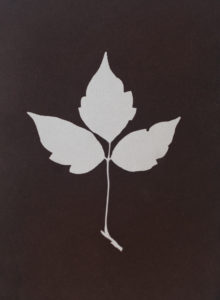The Analogue Dragon features prints made from historic photographic processes such as the cyanotype and salted paper print processes. Photography was first introduced to the world as a commercial process in by Louis Daguerre in 1839 and during that same time period others were also developing photographic processes such as Henry Fox Talbot, inventor of the salted paper print and Sir John Herschel, inventor of the cyanotype process.
Learn more about the processes below.
Cyanotype
Pam makes original photographic prints using the historic cyanotype process, a process first developed in the 1840’s by Sir John Herschel and patented by him in 1841. Cyanotypes were used from the 1870’s to the 1950’s to make copies of architectural prints and is why they are still referred to as “blue prints” today.
To make a botanical cyanotype print, a yellow light- sensitive solution is applied to the surface of paper. It is dried in the dark, then a pressed plant is positioned on top of the dry paper and both are placed outside to expose the solution to ultraviolet light. When the ultraviolet light strikes the yellow solution, a chemical reaction happens that turns it into prussian blue!
The last step of the cyanotype process is to rinse the print in water for 20 minutes to remove any of the unused solution.
Salted Paper Prints
Pam also makes original photographic prints using the historic salted paper print process, a process first developed in the 1840’s and patented in 1841.
To make her salted paper prints, a salt solution is applied to a paper surface. It is dried and then under tungsten light, a silver nitrate solution is applied on top of the salt solution. When the silver nitrate is dry, a film negative is placed on top of the coated paper and both are placed outside to expose the solution to the sun. When the ultraviolet light strikes the coated paper, a chemical reaction happens that turns it brown!
Once the exposure is made, the print needs to be rinsed with water to remove any unused solution from the paper surface and then fixed in sodium thiosulfate to remove any remaining silver halide that would otherwise continue to turn dark in light. The last step is to rinse the print for at least 30 minute to remove the sodium thiosulfate from the paper fibers.


Save
Save
Save


